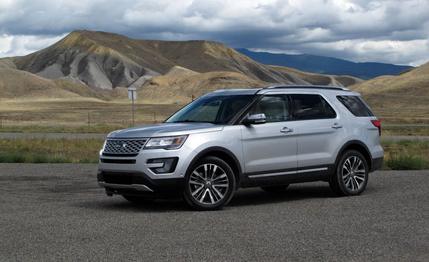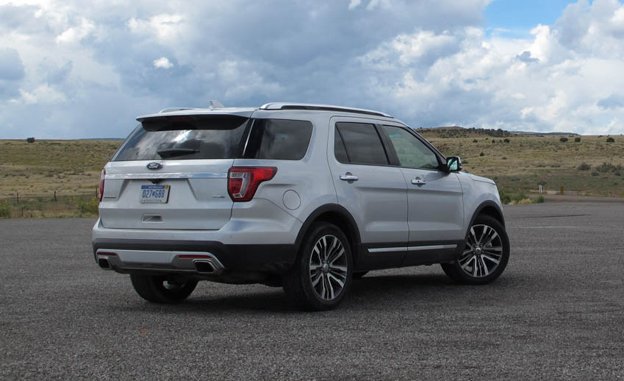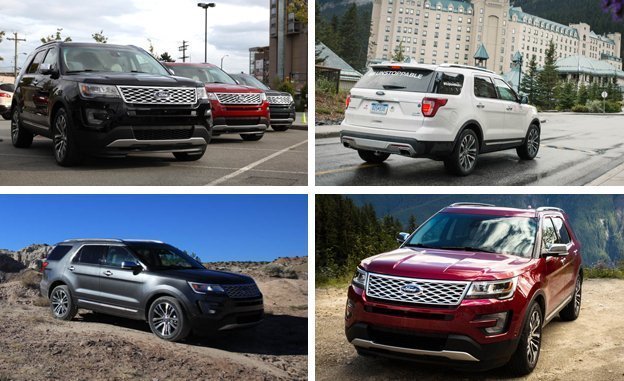
 First Drive Review
First Drive Review
The Ford Explorer Platinum edition went on sale last month promising to solve multiple problems for Ford. Problem One: The strongest engine offered in the popular Explorer SUV, the 3.5-liter EcoBoost V-6, would sell in greater numbers if Ford made it more widely available. This is only a problem because it would seriously drag down the corporate fuel-economy figure, given the Explorer’s sales volume. The best way to restrict the max-power engine’s percentage of the mix is to make it expensive or limit it to a low-volume model. Offering the V-6 EcoBoost only in the Sport trim, as was the case with the 2011–2015 Explorer, did both. But that irritated some potential customers, those who walk into dealerships wanting it all. These folk don’t take kindly to being told they can only have the 365 horsepower mill if they give up their preference for a soft ride and a big shiny grille (the Sport’s is black) or can’t get all the optional features they could in a luxury-oriented Limited. The trick is to limit EcoBoost penetration without irritating the wealthiest potential customers. Competitors cater to such buyers with offerings like the GMC Acadia Denali.
Problem Two is that the obvious alternative, sending the luxury buyer to the Lincoln store, isn’t really viable despite that brand’s sales rebound. One symptom of Lincoln’s recent identity crisis is that Dearborn forgot to give its dealers a version of the Explorer. Where once they had the Aviator, the only Lincoln sharing the Explorer platform is the MKT, an oddly styled analog to the boxy Ford Flex, which itself is all but salesproof despite our repeatedly stated preference for its lower center of gravity and sensible packaging. With luxury crossover/SUV sales hot and profit margins high, Ford leaves money on the table every time a shopper looking for a leather-lined, feature-rich, three-row crossover opts for an Acura MDX or an Audi Q7. The obvious solution is now at hand: a more luxurious, more expensive Explorer. They’ve sold 7 million Explorers in 25 years, after all, establishing a huge and loyal customer base that includes many who are ready to spend whatever it takes to get all the comforts and luxury trimmings.


The way Ford marketers tell the tale, the new Platinum combines the luxury features of the Limited with the enhanced performance of the Sport. Just adding the EcoBoost V-6 option to the Limited trim level would have accomplished that, though. Filling the corporate weak spot in the luxury segment, while making sure that Ford can hit the increasingly stringent fuel-economy bogey, demands something more. More expensive and profitable, more customer-pleasing, more “exclusive.” Hence the range-topping, bring-it-all-and-then-add-some-more Platinum.
Ford introduced this maximized Explorer with a five-stage drive starting in Vancouver, British Columbia, and wandering through the scenic western regions of the continent to finish up in Albuquerque, New Mexico (#ExploreMore, of course). We joined for the segment from Grand Junction to Durango, Colorado. Those were the only mandated stops—in between, we were free to roam the mountains and canyons, linking picturesque small towns with wide-open non-interstate highways. Playing tourist, stopping to take photos and climb on rocks, wait on flag stations to get by a big construction project, poke around museums, and gape at abandoned mines, it took us 12 hours to travel just over 210 miles. To the car’s credit—and fulfilling its mission—we ended the day pain-free and fresh as you could hope for after such a journey.
We’d just finished driving the Sport model when we boarded the plane for Colorado. Driving the Platinum was much the same, with plenty of V-8–like thrust from the twin-turbo six routed through the same six-speed automatic. Note that competitors are using eight- and nine-speed automatic transmissions, so Ford has another avenue to improve fuel economy while keeping this engine in the mix as requirements grow tighter.
One difference from the Sport is steering feel—the Platinum has a slower steering ratio tuned for a more linear response curve, so it doesn’t dive into a corner or swap lanes quite as sharply as does the Sport. The suspension tuning also is more comfort-oriented, but not in a sloppy, wallowy way. Braking and handling felt secure and safe through high mountain passes and switchbacks, where excitement isn’t really the priority for those driving a 5000-pound SUV full of family and gear. We got to use the Terrain Management System’s sand-and-gravel setting on an extended venture down a canyon trail, although the normal position seemed to adapt pretty well on its own. We didn’t get quite so adventurous as to need the hill-descent assist, but it’s there for those who have more time to wander.
Taking the Platinum above and beyond Limited-grade involves quilted leather for the supportive if somewhat wide seats, wrapping the dashboard and chunky steering wheel with contrast-stitched leather accented with real wood and aluminum trim, and highlighting the exterior with satin-chrome accents and 20-inch aluminum wheels. It also includes as standard a dual-panel sunroof, lane-keeping assist, rain-sensing wipers, and adaptive cruise control with forward-collision warning and braking. While Ford makes much of the washers for the front and rear cameras, we wished more for headlight washers to clear a full day of dust and bug accumulation when darkness fell in the mountains south of Silverton. While harping on the lighting situation, we’ll say the Platinum should include a stronger set to match the offerings on luxury brands.


Platinums also have a 500-watt/12-speaker Sony audio system employing the Live Acoustics and Clear Phase technologies Sony previously has used only for in-home systems—you can’t get it on lesser Explorers (yet, anyway). It did sound better than the unit in the Sport, a little richer and cleaner, although we were feeding it MP3s or satellite radio, neither format known as a favorite of audiophiles.
Also included is the latest generation of Ford’s active park assist, which will help you exit a parking space as well as enter it. It’ll do reverse perpendicular parking as well as parallel. We didn’t find a need for that feature in the wide-open American West, but urban dwellers with a bent toward the future of autonomous driving may enjoy it, at least to score show-off points at the theater.
The give-me-everything customer has only a few extracost options available to inflate the $53,915 base sticker of the Explorer Platinum. Some paint choices demand a $395 premium, second-row bucket seats are $695, and DVD screens in the back of the front headrests command $1995. After that, pushing the price tag up would require a free-spending approach to the catalog of dealer accessories.
This price will get you into a lot of entry-luxury alternatives, but the value is there in the Platinum’s content and quiet yet powerful demeanor. The argument against it might boil down to preferring a more prestigious nameplate than Ford. Platinum buyers will at least find that the oval badge on their steering wheels is executed in classy, brushed aluminum.